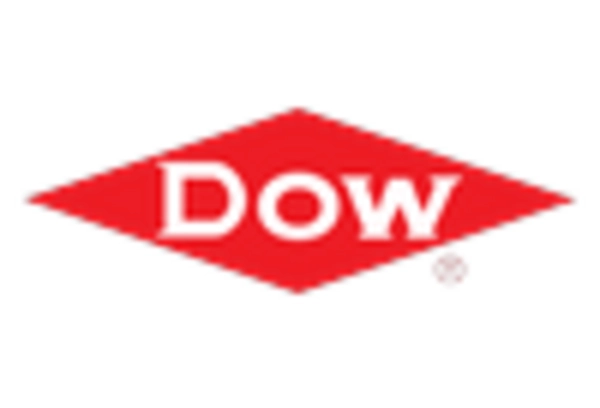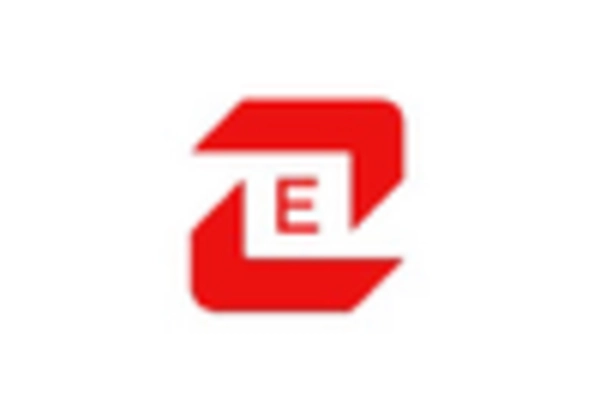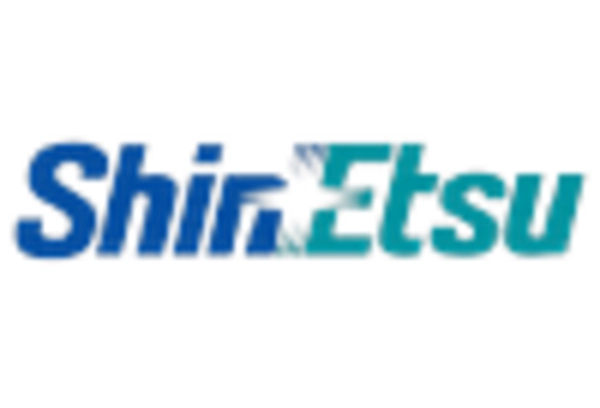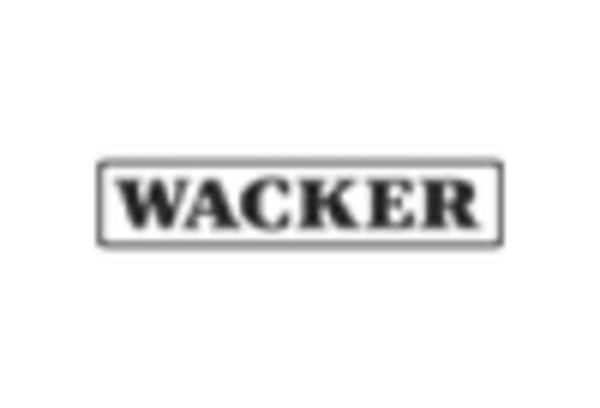-
Executive Summary
-
Market Introduction
-
Market Definition
-
Scope of the Study
-
Assumptions &
-
Limitations
-
Market Structure
-
Key Takeaways
-
Market Insights
-
Research Methodology
-
Research Process
-
Primary Research
-
Secondary Research
-
Market Size Estimation
-
Forecast
-
Model
-
Market Dynamics
-
Introduction
-
Drivers
-
Restraints
-
Opportunities
-
Challenges
-
Trends
-
Market
-
Factor Analysis
-
Supply Chain Analysis
- Raw Material Suppliers
- Manufacturers/Producers
- Distributors/Retailers/Wholesalers/E-Commerce
- End-Users
-
Merchants
-
Porter’s Five Forces Analysis
- Threat of New Entrants
- Intensity of Competitive Rivalry
- Threat of Substitutes
- Bargaining Power of Suppliers
-
Bargaining Power of Buyers
-
Pricing Analysis
-
Global Fluorosilicone
-
(FVMQ) Rubber Market, by Processing Technology
-
Introduction
-
Compression
- Market Estimates & Forecast, 2020–2027
-
Molding
-
Market Estimates & Forecast, by Region, 2020–2027
-
Extrusion
- Market Estimates & Forecast, 2020–2027
- Market Estimates
-
& Forecast, by Region, 2020–2027
-
Liquid Injection Molding
- Market Estimates & Forecast, 2020–2027
- Market Estimates
-
& Forecast, by Region, 2020–2027
-
Calendaring
- Market
- Market Estimates & Forecast,
-
Estimates & Forecast, 2020–2027
-
by Region, 2020–2027
-
3D Printing
- Market Estimates &
- Market Estimates & Forecast, by Region,
-
Forecast, 2020–2027
-
Others
- Market Estimates & Forecast, 2020–2027
- Market Estimates & Forecast, by Region, 2020–2027
-
Global
-
Fluorosilicone (FVMQ) Rubber Market, by End-Use Industry
-
Introduction
-
Automotive
- Market Estimates & Forecast, 2020–2027
- Market Estimates & Forecast, by Region, 2020–2027
-
Aerospace
- Market Estimates & Forecast, 2020–2027
-
& Defense
-
Market Estimates & Forecast, by Region, 2020–2027
-
Oil & Gas
- Market Estimates & Forecast, 2020–2027
- Market Estimates
-
& Forecast, by Region, 2020–2027
-
Electronics & Semiconductors
- Market Estimates & Forecast, 2020–2027
- Market Estimates
-
& Forecast, by Region, 2020–2027
-
Others
- Market Estimates
- Market Estimates & Forecast, by Region,
-
& Forecast, 2020–2027
-
Global Fluorosilicone (FVMQ) Rubber Market, by Region
-
Introduction
-
North America
- Market Estimates & Forecast,
- Market Estimates & Forecast, by Processing Technology,
- Market Estimates & Forecast, by End-Use Industry,
- US
- Canada
-
Europe
- Market Estimates & Forecast, 2020–2027
-
Market Estimates & Forecast, by Processing Technology, 2020–2027
-
Market Estimates & Forecast, by End-Use Industry, 2020–2027
-
Germany
-
Market Estimates & Forecast, 2020–2027
-
Market Estimates & Forecast, by Processing Technology, 2020–2027
-
Market Estimates & Forecast, by End-Use Industry, 2020–2027
-
France
-
Market Estimates & Forecast, 2020–2027
-
Market Estimates & Forecast, by Processing Technology, 2020–2027
-
Market Estimates & Forecast, by End-Use Industry, 2020–2027
-
Italy
-
Market Estimates & Forecast, 2020–2027
-
Market Estimates & Forecast, by Processing Technology, 2020–2027
-
Market Estimates & Forecast, by End-Use Industry, 2020–2027
-
Spain
-
Market Estimates & Forecast, 2020–2027
-
Market Estimates & Forecast, by Processing Technology, 2020–2027
-
Market Estimates & Forecast, by End-Use Industry, 2020–2027
-
UK
-
Estimates & Forecast, by Processing Technology, 2020–2027
-
Market Estimates & Forecast, 2020–2027
-
Market
-
Market Estimates & Forecast, by End-Use Industry, 2020–2027
-
Russia
-
Market Estimates & Forecast, 2020–2027
-
Market Estimates & Forecast, by Processing Technology, 2020–2027
-
Market Estimates & Forecast, by End-Use Industry, 2020–2027
-
Poland
-
Market Estimates & Forecast, 2020–2027
-
Market Estimates & Forecast, by Processing Technology, 2020–2027
-
Market Estimates & Forecast, by End-Use Industry, 2020–2027
-
Asia-Pacific
- Market Estimates & Forecast, 2020–2027
- Market Estimates
- Market Estimates
- China
- India
- Japan
- Australia &
-
& Forecast, by Processing Technology, 2020–2027
-
& Forecast, by End-Use Industry, 2020–2027
-
Market Estimates & Forecast, 2020–2027
-
Forecast, by Processing Technology, 2020–2027
-
& Forecast, by End-Use Industry, 2020–2027
-
Market Estimates & Forecast, 2020–2027
-
Forecast, by Processing Technology, 2020–2027
-
& Forecast, by End-Use Industry, 2020–2027
-
Market Estimates & Forecast, 2020–2027
-
Forecast, by Processing Technology, 2020–2027
-
& Forecast, by End-Use Industry, 2020–2027
-
New Zealand
-
Market Estimates & Forecast, by Processing Technology, 2020–2027
-
Market Estimates & Forecast, by End-Use Industry, 2020–2027
-
Rest of Asia-Pacific
-
Market Estimates & Forecast, 2020–2027
-
Market Estimates & Forecast, by Processing Technology, 2020–2027
-
Market Estimates & Forecast, by End-Use Industry, 2020–2027
-
Middle East & Africa
- Market Estimates & Forecast, 2020–2027
- Market Estimates & Forecast, by Processing Technology, 2020–2027
- Market Estimates & Forecast, by End-Use Industry, 2020–2027
- Turkey
- Israel
- South Africa
- GCC
-
Market Estimates & Forecast, by Processing Technology, 2020–2027
-
Market Estimates & Forecast, by End-Use Industry, 2020–2027
-
Rest of the Middle East & Africa
-
& Forecast, 2020–2027
-
Processing Technology, 2020–2027
-
by End-Use Industry, 2020–2027
-
Market Estimates & Forecast,
-
Market Estimates & Forecast, by Processing Technology,
-
Market Estimates & Forecast, by End-Use Industry,
-
Latin America
- Market Estimates & Forecast,
- Market Estimates & Forecast, by Processing Technology,
- Market Estimates & Forecast, by End-Use Industry,
- Brazil
- Argentina
- Mexico
- Rest of Latin America
-
Competitive Landscape
-
Introduction
-
Key Market Strategy Analysis
-
Key Development Analysis
-
(Expansions/Mergers
-
& Acquisitions/Joint Ventures/New Product Developments/Agreements/Investments)
-
Company Profiles
-
Dow
- Company Overview
- Product/Business Segment Overview
- Key
- SWOT Analysis
- Key Strategies
-
Financial Overview
-
Developments
-
Wacker
- Company Overview
- Financial Overview
- Key Developments
- SWOT
- Key Strategies
-
Chemie AG
-
Product/Business Segment Overview
-
Analysis
-
Momentive
- Company Overview
- Financial Overview
- Product/Business Segment Overview
- SWOT Analysis
- Key Strategies
- Company Overview
- Financial Overview
- Key Developments
- SWOT
- Key Strategies
-
Key Developments
-
James Walker
-
Product/Business Segment Overview
-
Analysis
-
Rogers Corporation
- Company
- Financial Overview
- Product/Business Segment Overview
- Key Developments
- SWOT Analysis
- Key Strategies
-
Overview
-
Shin-Etsu Chemical Co., Ltd
- Company Overview
- Financial
- Product/Business Segment Overview
- Key Developments
- SWOT Analysis
- Key Strategies
-
Overview
-
Shanghai Fluoron Chemicals
- Company Overview
- Financial Overview
- Product/Business
- Key Developments
- SWOT Analysis
-
Segment Overview
-
Key Strategies
-
STOCKWELL ELASTOMERICS, INC.
- Company Overview
- Financial Overview
- Product/Business Segment Overview
- SWOT Analysis
- Key Strategies
- Company Overview
- Financial
- Product/Business Segment Overview
- Key Developments
- SWOT Analysis
- Key Strategies
-
Key Developments
-
Shanghai 3F New Materials Co., Ltd
-
Overview
-
NUSIL
- Financial Overview
- Product/Business Segment
- Key Developments
- SWOT Analysis
- Key
-
Company Overview
-
Overview
-
Strategies
-
Primasil Silicones Limited
- Company Overview
- Financial Overview
- Product/Business Segment Overview
- SWOT Analysis
- Key Strategies
- Company Overview
- Financial
- Product/Business Segment Overview
- Key Developments
- SWOT Analysis
- Key Strategies
-
Key Developments
-
Hangzhou Fine Fluorotech Co., Ltd
-
Overview
-
Appendix
-
-
LIST OF TABLES
-
Global Fluorosilicone (FVMQ) Rubber Market, by Region,
-
North America: Fluorosilicone (FVMQ) Rubber Market,
-
by Country, 2020–2027
-
Europe: Fluorosilicone (FVMQ) Rubber Market,
-
by Country, 2020–2027
-
Asia-Pacific: Fluorosilicone (FVMQ) Rubber
-
Market, by Country, 2020–2027
-
Middle East & Africa: Fluorosilicone
-
(FVMQ) Rubber Market, by Country, 2020–2027
-
Latin America: Fluorosilicone
-
(FVMQ) Rubber Market, by Country, 2020–2027
-
Global Fluorosilicone
-
(FVMQ) Rubber Market, for Processing Technology, by Region, 2020–2027
-
North America: Fluorosilicone (FVMQ) Rubber Market, for Processing Technology,
-
by Country, 2020–2027
-
Europe: Fluorosilicone (FVMQ) Rubber Market,
-
for Processing Technology, by Country, 2020–2027
-
Asia-Pacific:
-
Fluorosilicone (FVMQ) Rubber Market, for Processing Technology, by Country, 2020–2027
-
Middle East & Africa: Fluorosilicone (FVMQ) Rubber Market, for
-
Processing Technology, by Country, 2020–2027
-
Latin America:
-
Fluorosilicone (FVMQ) Rubber Market, for Processing Technology, by Country, 2020–2027
-
Global Fluorosilicone (FVMQ) Rubber Market, for End-Use Industry,
-
by Region, 2020–2027
-
North America: Fluorosilicone (FVMQ) Rubber
-
Market, for End-Use Industry, by Country, 2020–2027
-
Europe:
-
Fluorosilicone (FVMQ) Rubber Market, for End-Use Industry, by Country, 2020–2027
-
Asia-Pacific: Fluorosilicone (FVMQ) Rubber Market, for End-Use Industry,
-
by Country, 2020–2027
-
Middle East & Africa: Fluorosilicone
-
(FVMQ) Rubber Market, for End-Use Industry, by Country, 2020–2027
-
Table
-
Latin America: Fluorosilicone (FVMQ) Rubber Market, for End-Use Industry, by
-
Country, 2020–2027
-
Global Processing Technology Market, by
-
Region, 2020–2027
-
Global End-Use Industry Market, by Region,
-
North America: Fluorosilicone (FVMQ) Rubber Market,
-
by Country, 2020–2027
-
North America: Fluorosilicone (FVMQ) Rubber
-
Market, by Processing Technology, 2020–2027
-
North America: Fluorosilicone
-
(FVMQ) Rubber Market, by End-Use Industry, 2020–2027
-
Europe:
-
Fluorosilicone (FVMQ) Rubber Market, by Country, 2020–2027
-
Europe:
-
Fluorosilicone (FVMQ) Rubber Market, by Processing Technology, 2020–2027
-
Europe: Fluorosilicone (FVMQ) Rubber Market, by End-Use Industry, 2020–2027
-
Asia-Pacific: Fluorosilicone (FVMQ) Rubber Market, by Country, 2020–2027
-
Asia-Pacific: Fluorosilicone (FVMQ) Rubber Market, by Processing Technology,
-
Asia-Pacific: Fluorosilicone (FVMQ) Rubber Market,
-
by End-Use Industry, 2020–2027
-
Middle East & Africa: Fluorosilicone
-
(FVMQ) Rubber Market, by Country, 2020–2027
-
Middle East &
-
Africa: Fluorosilicone (FVMQ) Rubber Market, by Processing Technology, 2020–2027
-
Middle East & Africa: Fluorosilicone (FVMQ) Rubber Market, by
-
End-Use Industry, 2020–2027
-
Latin America: Fluorosilicone (FVMQ)
-
Rubber Market, by Country, 2020–2027
-
Latin America: Fluorosilicone
-
(FVMQ) Rubber Market, by Processing Technology, 2020–2027
-
Latin
-
America: Fluorosilicone (FVMQ) Rubber Market, by End-Use Industry, 2020–2027
-
-
LIST OF FIGURES
-
Global Fluorosilicone (FVMQ) Rubber
-
Market Segmentation
-
Forecast Methodology
-
Porter’s
-
Five Forces Analysis of Global Fluorosilicone (FVMQ) Rubber Market
-
FIGURE 4
-
Supply Chain Analysis of Global Fluorosilicone (FVMQ) Rubber Market
-
FIGURE
-
Share of Fluorosilicone (FVMQ) Rubber Market, by Country, 2020 (%)
-
FIGURE
-
Global Fluorosilicone (FVMQ) Rubber Market, 2020–2027
-
Sub-Segments
-
of Processing Technology
-
Global Fluorosilicone (FVMQ) Rubber Market
-
Size, by Processing Technology, 2020 (%)
-
Share of Global Fluorosilicone
-
(FVMQ) Rubber Market, by Processing Technology, 2020–2027
-
Sub-Segments
-
of End-Use Industry
-
Global Fluorosilicone (FVMQ) Rubber Market Size,
-
by End-Use Industry, 2020 (%)
-
Share of Global Fluorosilicone (FVMQ)
-
Rubber Market, by End-Use Industry, 2020–2027
















Leave a Comment